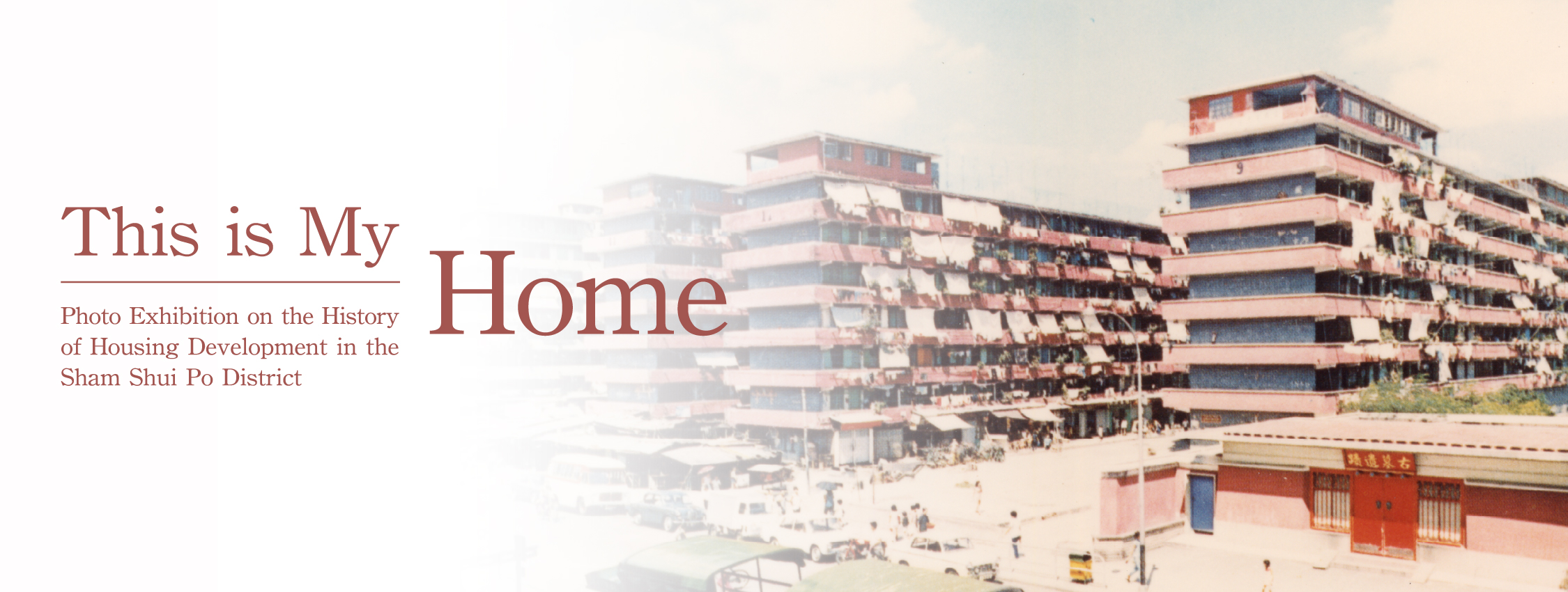
About the Collection

In 1906, the government began land sale in Sham Shui Po to the public. A number of reclamation projects were carried out in the 1910s, and several roads were built that facilitated the district’s urbanisation. Transport links were also gradually established between Sham Shui Po and urban area of Kowloon, and the district developed into a new community that was home to a large proportion of the territory’s population.
In the 1920s, most of the buildings constructed in Sham Shui Po were tong lau (tenement houses). The supply of tong lau was not enough, however, to accommodate the influxes of new immigrants fleeing to Hong Kong from Mainland China after the Second World War, and new residents began squatting in wooden huts that they built themselves. The tragic fire in the Shek Kip Mei squatter areas in 1953 prompted the government to construct resettlement blocks, and Shek Kip Mei Estate was built as the first generation public housing in Hong Kong. At the same time, voluntary organisations also financed the construction of low-cost housing to offer other options for squatters. Hong Kong’s booming economy in the 1960s led to the expansion of the middle class and new demands for housing, and Sham Shui Po subsequently saw the completion of the first large private housing estate in Hong Kong: Mei Foo Sun Chuen. Public housing in the district was redeveloped in phases from the 1970s to the 1990s, while flats were also completed in the district under “Home Ownership Scheme” from the 1980s to the 2000s, injecting different characteristics into Sham Shui Po’s housing stock.
Home to an array of different types of housing, Sham Shui Po bears witness to the different social circumstances of successive eras. By introducing the main types of early housing found in the district, the exhibition on “This is My Home: Photo Exhibition on the History of Housing Development in the Sham Shui Po District”, held from October 2017 to January 2019 at the Lei Cheng Uk Han Tomb Museum, illustrates the development of housing in Sham Shui Po during the 20th century.
This collection presents the contents and materials of the above exhibition, and supplementary materials subsequently provided by the Hong Kong Museum of History, allowing the general public to go over the story of housing development in Sham Shui Po.
About the Collection

In 1906, the government began land sale in Sham Shui Po to the public. A number of reclamation projects were carried out in the 1910s, and several roads were built that facilitated the district’s urbanisation. Transport links were also gradually established between Sham Shui Po and urban area of Kowloon, and the district developed into a new community that was home to a large proportion of the territory’s population.
In the 1920s, most of the buildings constructed in Sham Shui Po were tong lau (tenement houses). The supply of tong lau was not enough, however, to accommodate the influxes of new immigrants fleeing to Hong Kong from Mainland China after the Second World War, and new residents began squatting in wooden huts that they built themselves. The tragic fire in the Shek Kip Mei squatter areas in 1953 prompted the government to construct resettlement blocks, and Shek Kip Mei Estate was built as the first generation public housing in Hong Kong. At the same time, voluntary organisations also financed the construction of low-cost housing to offer other options for squatters. Hong Kong’s booming economy in the 1960s led to the expansion of the middle class and new demands for housing, and Sham Shui Po subsequently saw the completion of the first large private housing estate in Hong Kong: Mei Foo Sun Chuen. Public housing in the district was redeveloped in phases from the 1970s to the 1990s, while flats were also completed in the district under “Home Ownership Scheme” from the 1980s to the 2000s, injecting different characteristics into Sham Shui Po’s housing stock.
Home to an array of different types of housing, Sham Shui Po bears witness to the different social circumstances of successive eras. By introducing the main types of early housing found in the district, the exhibition on “This is My Home: Photo Exhibition on the History of Housing Development in the Sham Shui Po District”, held from October 2017 to January 2019 at the Lei Cheng Uk Han Tomb Museum, illustrates the development of housing in Sham Shui Po during the 20th century.
This collection presents the contents and materials of the above exhibition, and supplementary materials subsequently provided by the Hong Kong Museum of History, allowing the general public to go over the story of housing development in Sham Shui Po.














